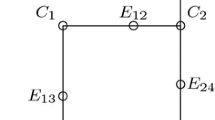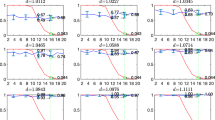Abstract
A model of a random mating diploid population with non-overlapping generations is considered. The dynamics of the population-genetic structure (with respect to a set of autosomal loci) under the pressure of recombination and segregation is investigated. In discrete time, the model is described by difference equations with respect to the population genetic state (the vector of multilocus gamete frequencies). Transition from the state description in terms of gamete frequencies to the description in terms of the fixed reference state with independent combining of alleles in gametes and deviations from such independence (gametic disequilibria) is made. According to the first part of the communication, it is possible to select among gametic disequilibria the basis ones, and the others are decomposed into the basis disequilibria. Basis gametic disequilibria have a hierarchical organization, which is determined by the number of loci starting from which it becomes possible to find the existing disequilibrium. From this point of view, we characterize the known results on the convergence of the multilocus genetic structure to an equilibrium state with independent combining of alleles in gametes. Basis gametic disequilibria of the first level of hierarchy decay the fastest. They are observed only at investigation of the whole given set of studied loci simultaneously and they cannot be discovered on the subsets of smaller sizes. Gametic disequilibria of the second level of hierarchy have slower rates of decay. These disequilibria are observed starting from the subsets of loci one unit less in size, but they are invisible at a smaller quantity of loci, etc. The description is based on the use of the coordinate system developed by S. Karlin and U. Liberman in analysis of non-epistatic selection models, but considered from another angle of view. Justification of the results assumes that readers are familiar with the basics of linear algebra and, in particular, the properties of Kronecker multiplication.
Similar content being viewed by others
References
Li Ching Chun, First Course in Population Genetics, Pacific Grove: Boxwood, 1976.
Svirezhev, Y.M. and Passekov, V.P., Fundamentals of Mathematical Evolutionary Genetics, Dordrecht: Kluwer Academic Publishers, 1990.
Lyubich, Y.I., Mathematical Structures in Population Genetics, Berlin: Springer-Verlag, 1992.
Lewontin, R.C. and Kojima, K, The evolutionary dynamics of complex polymorphisms, Evolution, 1960, vol. 4, no. 4, pp. 458–472.
Bennett, J.H, On the theory of random mating, Ann. Eugenics, 1954, vol. 18, pp. 311–317.
Slatkin, M, On treating the chromosome as the unit of selection, Genetics, 1972, vol. 72, no. 1, pp. 157–168.
Dawson, K.J, The decay of linkage disequilibrium under random union of gametes: how to calculate Bennett’s principal components, Theor. Popul. Biol., 2000, vol. 58, no. 1, pp. 1–20.
Karlin, S. and Liberman, U, Global convergence properties in multilocus viability selection models: the additive model and the Hardy—Weinberg law, J. Math. Biol., 1990, vol. 29, no. 2, pp. 161–176.
Passekov, V.P, About multilocus genetic structure of a population: I. Description of gametic disequilibrium architecture, Russ. J. Genet., 2017, vol. 53, no. 6, pp. 719–731.
Markus, M. and Mink, X., A Survey of Matrix Theory and Matrix Inequalities, Prindle: Weber and Schmidt, 1964.
Lancaster, P., Theory of Matrices, New York: Academic, 1969.
Passekov, V.P., On the analysis of perturbations of the neutral multilocus model of population genetics, in Issledovanie operatsii (Operational Research), Moscow: Vychislitel’nyi Tsentr Rossiiskoi Akademii Nauk, 1994, pp. 51–86.
Hedrick, P.W., Genetics of Populations, Boston: Jones and Bartlett, 2003.
Passekov, V.P., On the genetic interpretation of eigenvectors for the generalized model of nonepistatic selection, Preprint of the Erwin Shrödinger International Inst. for Mathematical Physics, ESI Preprint Series, Vienna, 2003, no. 1329, p. 14.
Author information
Authors and Affiliations
Corresponding author
Additional information
Original Russian Text © V.P. Passekov, 2017, published in Genetika, 2017, Vol. 53, No. 7, pp. 856–871.
Rights and permissions
About this article
Cite this article
Passekov, V.P. On multilocus population genetic structure: II. Gametic disequilibrium dynamics under recombination–segregation pressure. Russ J Genet 53, 820–833 (2017). https://doi.org/10.1134/S1022795417060114
Received:
Accepted:
Published:
Issue Date:
DOI: https://doi.org/10.1134/S1022795417060114




